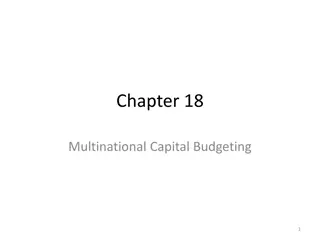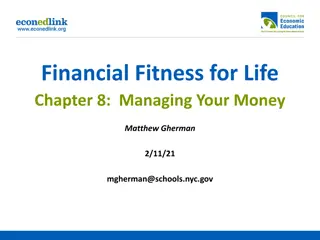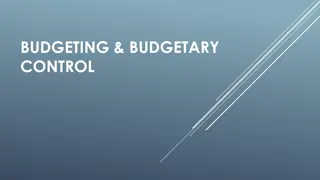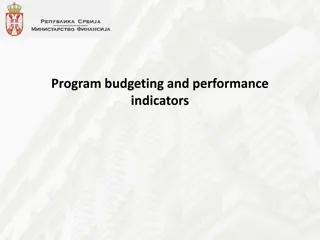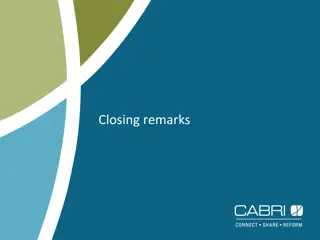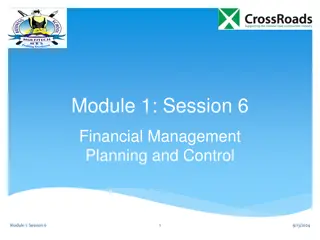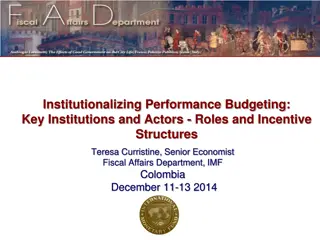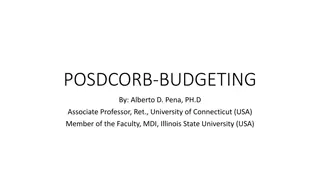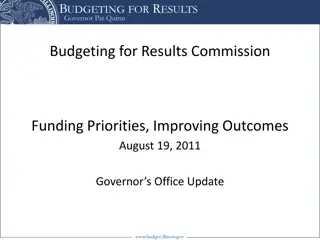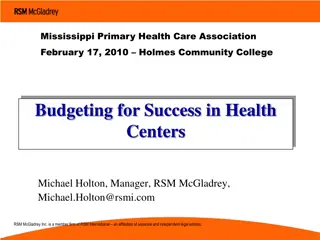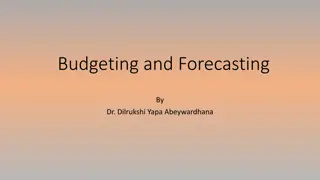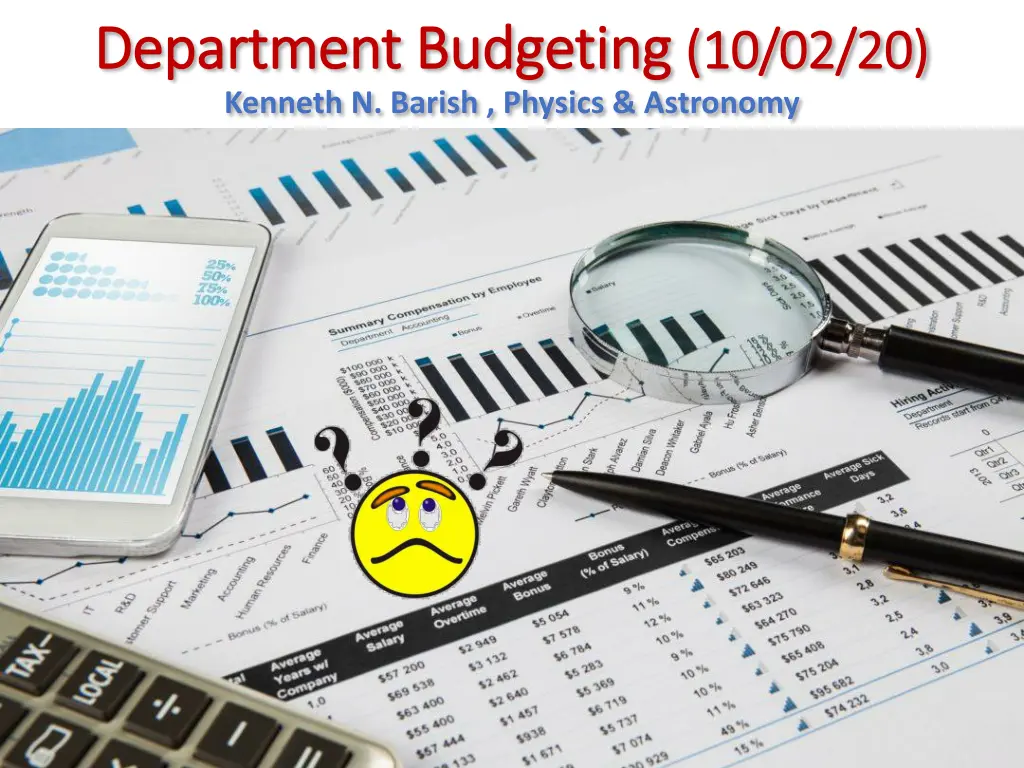
University Budgeting and Allocation in Higher Education System
Explore the intricate web of budgeting and resource allocation in the university system, focusing on revenue sources, tuition distribution, and decentralized budget models. Discover how funds are managed across various departments to support academic programs and student aid initiatives.
Uploaded on | 2 Views
Download Presentation

Please find below an Image/Link to download the presentation.
The content on the website is provided AS IS for your information and personal use only. It may not be sold, licensed, or shared on other websites without obtaining consent from the author. If you encounter any issues during the download, it is possible that the publisher has removed the file from their server.
You are allowed to download the files provided on this website for personal or commercial use, subject to the condition that they are used lawfully. All files are the property of their respective owners.
The content on the website is provided AS IS for your information and personal use only. It may not be sold, licensed, or shared on other websites without obtaining consent from the author.
E N D
Presentation Transcript
Department Budgeting Department Budgeting (10/02/20) Kenneth N. Barish , Physics & Astronomy (10/02/20)
University Budget (Systemwide) UC budget proposed by UCOP to Regents Funding Streams Model most money remains on campuses. UCOP and system wide imitative are funded by a tax, currently set at 2.65%. Rebenching each campus is now receiving the same amount of money per budgeted student in each category. Concepts such as faculty lines and NRT expenses for graduate students are outdated. Role of Academic Senate --University Committee on Planning and budget (derived from Regents standing order): 1) Confer with and advise the President and agencies of the University Administration on policy regarding planning and budget matters and resource allocations. 2) Initiate studies in planning and budget matters.
University Budget (campus) State and tuition represent a majority of UCR revenues, considerably more than other campuses. We receive more back in student aid then our students put into the pool. [33% of student tuition is centralized for aid]
UCRs decentralized budget model Note that the University is a series of Cross-Subsidizations Revenue Sources Revenue Sources Tuition & Fees Contracts & Grants Gifts Auxiliary State Appropriations Other Revenue Subvention & Strategic Investment Funds Auxiliary / Self- Supporting Enterprises Revenue Recipient Academic Units ALL UNITS Infrastructure ..& SUPPORT UNITS Cost Pools Administration ALL UNITS Academic & Research Support ACADEMIC, AUXILIARY/SELF- SUPPORTING Student Support ACADEMIC UNITS ONLY Auxiliary / Self-Supporting Enterprises Academic Units Central Support (Subvention & Strategic Investment Funds) Subvention & Strategic Investment Funds Key 5 Revenue Sources Revenue Centers Cost Centers Central Support Revenue Flow Cost Allocation Flow Central Support Flow
Tuition allocation In FY15-16, 70% of the net undergraduate tuition base was assigned to the Schools and Colleges 33% 67% to Financial Aid Net Tuition Revenue Available 30% Net Tuition Revenue Available 70% to Campus/ Subvention Pool* to Schools and Colleges 5
Tuition Distribution to Colleges / Schools Graduate Student Tuition Undergraduate Student Tuition1,2 2016-17 Workload/Credit Hours (60%) Headcount Major (20%) 2016-17 2017-18 2017-18 Ph.D. Headcount $0 $0 $3,380 $3,351 MA/S & MFA Headcount (67%) $7,517 $7,517 $1,067 $1,068 Professional MA Headcount (50%) $5,610 $5,610 The Performance Bonus Pool (20%) will be collaboratively reevaluated during FY17-18 based on feedback received and will consider the following: Non-Resident Tuition 2016-17 2017-18 Undergraduate Headcount (70%) $16,271 $17,047 Incentive-based for varying strategic needs (increasing grad rates or transfer students) Funding central resources for fixed cost increases or other strategic initiatives Ph.D. Headcount $0 $0 MA/S & MFA Headcount (70%) $7,873 $8,150 1. Net available revenue is after the financial aid and split with 30% going into central resources for fixed cost increases 2. Stated values for Undergraduate and Non-Resident Tuition are based on a 3-year historical average of actual revenue (net of waivers). Professional MA Headcount (70%) $8,410 $8,406 6
Campus Budget Process Service Providers --Includes, e.g. facilities and BAS, but also Research, Graduate and Undergraduate Education Revenue generators --Colleges and schools
College Budgets Revenues (selected): --$/student FTE (formula, class, major, performance) --Subvention funding (cross-subsidies) --Course material fees --Self-supporting and professional degree programs --Indirect cost recovery (30%) [5% to Dept and 5% to PI] --Portion of faculty initial complements (from campus) --Gifts and endowments Expenses (selected): --Faculty and staff salaries and benefits (pass through to departments) --TA salaries + tuition, etc. (pass through to departments) --Indirect costs for admin, facilities, etc --Portion of initial complements
Department Budgets 1. Authority: Supervisory & Budgetary 2. Departmental Permanent Funding 3. Departmental Temporary Funding 4. Summer Session allocations; University Extension allocatins 5. Student Instructional Fees 6. Other Funding: (teaching release, grad recruiting, faculty recruiting, staff cost savings , overhead return, student lab fees, etc.) 7. Grant Administration & Expenditures 8. Development Donations & Endowments 9. Sales and Service Facilities 10.Departmental Expenditures (Salaries, Inst. Labs, S&E, Grants and start-up matches, Seminars, Recruiting, etc.
1. Supervisorial Authority Staff support the faculty s education, research & outreach mission FAO/MSOs provide oversight of financial and administrate functions. They have longer tenure & historical memories than Chairs however, Chair has ultimate authority and responsibility for the department. Keep Supervisory Authority Clear & well Demarcated (e.g. complaints, overtime, staff appreciation, evaluations) Chair Chair FAO/MSO FAO/MSO Lab Supervisor Lab Supervisor FOM FOM SAO, Purchasing, M&P SAO, Purchasing, M&P Assistant, Travel + Assistant, Travel + Receiving Receiving Lab Staff (3) Lab Staff (3) Grants Analysts (3) Grants Analysts (3)
2. Permanent Funding (Salaries) Largest Component is Ladder Rank Faculty & Permanent Staff Salary and benefits --Paid for by College from Provost (Faculty + Staff Salary ~$6M). If a faculty separates, the salary remains in the college (not department) in most cases. If a Staff separates the Department retains the salary. Temporary teaching faculty and TAs paid by yearly allocation from College State funding comes with number 19900 with Budget Categories (BCXX) --BC10 Faculty salaries --BC13 Academic Coordinator salaries (none in Physics) --BC25 Staff salaries --BC 40 S&E subcategories [ next slide]
Permanent Funding (S&E) S&E Supplies and Expenses Budget (19900 cash to run the dept- Flexible $, Discretionary to Chair) --S&E = Budget Categories BC 40 e.g printing BC43, Facilities BC70) ~$120K/yr for a large dept Covers all dept purchases: --Xerox paper, computers, renovations, temporary staff, student assistants etc. (SLA s cover facility repairs and maintenance). S&E allocation should correlate with dept faculty size/ teaching- research workload and volume of transactions. --Periodic review of S&E every 2-3 yrs to assess need. --Current Review Metric is Total Expenditures by the Department (CNAS views this as a more comprehensive metric). College Financing of dept expenditures is possible Special Equipment loans from University can on rare occasions with typically 5 year terms to be repaid from grants can be obtained (interest is charged).
3. Departmental Temporary Funding Items that require proactive requests and justification to college Items that require proactive requests and justification to college Lecturers (~$10K;ca. $7000 CHASS) paid directly by college if authorized; TAs (Stipend + Tuition ~$12.5K/50% TA/quarter) --Paid directly by college ; About ~$11 M per year cost to college --Largest non fixed costs to the college and biggest uncertainty as it depends on enrollment and Union contracts. In Physics annually 200 TAs (50%) Cost $2.7 M / In History generally 32 TAs = 450,000 ( includes Salary and Tuition) Allocated to Department at start of year on projected enrollment for year. Supplementation/Adjustments done end of every quarter What if a Chair deems it necessary to overspend the allocation to meet teaching needs especially TAs? --Convince the college that expenditures are justified. --Otherwise pay the difference out of S&E or reserves , summers session $, Concurrent enrollment. --Or cancel classes or sections.
4. Summer Session Revenue Augmentation to Departmental Funding Augmentation to Departmental Funding- - Flexible use $ Flexible use $ Summer Session Allocations can be comparable or larger than Dept S&E: --SS generates ~$98K for Physics, ~$170K for Chem.; ~50 K for History Physics uses SS to support: --Colloquium, Seminars, GSRs and Fill in deficits Graduate and Faculty Recruiting Provides Direct Faculty Summer Salary --8.5% of AY salary per class. Ladder rank Faculty Participation enhances SS curriculum. SS classes reduce AY instructional Burden in impacted classes and helps time to graduation. Summer Session Revenue calculated by Summer Sessions under VPUE after expenses. --CNAS keeps 10% for facility upkeep and staff pay. CHASS keeps 30% Good way to grow Departmental revenue in general. Offer as many as possible. --Advertise (Newspaper Ads, Radio Ads)
5. Misc. Student Instructional Fees Course Material/Lab Fees (~$25-150/student) (Fund #20023) --Sizable budgets when multiplied by thousands of students: Total in Physics is $155K --Not Flexible $ - Only for Student Instruction connected with Lab supplies, computers, software etc. --can t be used for equipment i.e. only items <$5k. --for small items and consumables. --Fund Number 20023 UNEX Concurrent Enrollment Return to dept (Fund #20322) --Unrestricted (non-19900) revenue (e.g. can be used for alcohol purchase). --In Physics used to be $40k, now $22K- has decreased by 50% over the last 5 yrs ! --In History, UNEX funding has gone from $42K to $22 K- but a new source of UNEX Funding with XR-Funds is promising. 10% of gross revenue from student funds to the Department. This is our first year.
6. Other Funding Graduate Recruiting Funds (from grad division/Dean s office): --$10K/yr (Spent $11K); varies by Department Faculty Recruiting Funds (from admin): --Spent ~$23K for 2 searches ($16K reimbursed). --[For cluster hires paid by Provost, rest split between eventual depts of hires. These were put on hold in 2020] Grant Overhead Return: 5% PI, 5% Dept (30% college) --Biggest single source of discretionary $ Physics received $79K last year --CNAS dean requires 2.5:1 on initial complements, retentions, etc. --Any remainder can be used on strategic investments Teaching Release funds for Academic Senate/Admin Service: ~$5K-$10K per year. --ASMD used to be paid by Provost, but not in new budget model.
7. Grant Administration and Expenditures Requires adequate financial support staff Requires adequate financial support staff PI Grants: Submission, Oversight, Accounting, Monthly Reports, Projections, Purchasing, etc. Fund Numbers: 2xxxx or 3xxxx for Federal Grants 8xxxx for State Grants Grant Funds are not Taxable i.e. no UCOP 3.1% Tax on transactions. (Funding Streams) Matching Funds commitments: from, VCRED, Dean & Dept
8. Development Donations & Endowments Acquiring, Administering, Endowing, Expending Acquiring, Administering, Endowing, Expending Increase Cultivating Relationships with successful undergraduate alumni --Larger numbers and typically stronger reminiscences Graduation Recognition Ceremonies --Invite, Alumni, Emeriti faculty & Donors Prizes honoring the Donors Financial Administration: --Foundation Reports on Principal Balance, Dept reports on current balance, disbursement/utilization of expendable balance (3%/yr).
CHASS, Assistant Dean of Development, Clyde Derrick In CHASS, Assistant Dean Clyde Derrick and his Team, especially Rachel Pulido, have helped to develop outreach and to communicate with alumni as well as donors. --History has a spring Awards Ceremony to which we invite the Donors --Economics has a newsletter sent to alumni and Donors
9. Sales & Service Facilities Recharge Fees plus College and/or VCRED partial subsidy Recharge Fees plus College and/or VCRED partial subsidy Recharge shared facilities, e.g. Machine Shop, Glass Shop, ACIF, IIGB, Microscopy, Nano Fab etc. CNAS supports most Shared Instrumentation and Shops at ~50% --e.g. 50% permanent funding from college, 50% temporary funded from recharges. Depts usually administer these facilities. Lobbying for viable facilities support can require Chair involvement. Facility usage can be part of faculty start-up packages
10. Physics & Astronomy Expenditures Recharge Fees plus College and/or VCRED partial subsidy Recharge Fees plus College and/or VCRED partial subsidy Grant Expenditures ~$7.5M Faculty Salaries ~ $5M TAs ~$2.7M Staff Salaries ~$1M Benefits (~1/3 of Salaries)- Paid by College Misc Salaries: ~$20k Overtime: 150% (straight <40hrs/wk) Work Study helpers (e.g. Student lab assistants) Instructional lab support purchases ~$85k General S&E, Facilities ~$106K Faculty Recruitment $22K ($6K cost to department) Seminars/Colloquium $18k/yr Graduate Recruiting $10k/yr ($1K cost to department)
11. History Department Expenditures Faculty Salaries ~ $ 3,941,907. Staff Salaries ~$184,806TAs ~$450,000 Work Study helpers (e.g. Student Department assistants)~$10- 15,000 General S&E, Facilities ~$ 20,000 Seminars/Colloquium ~ $25,000 (seminars, colloquium, research symposium, faculty sponsored events) Graduate Recruiting ~ $ 5000 ($3500 reimbursed by Grad Division) Grant Expenditures ~ $481,000 in 2019-2020; these vary greatly.


